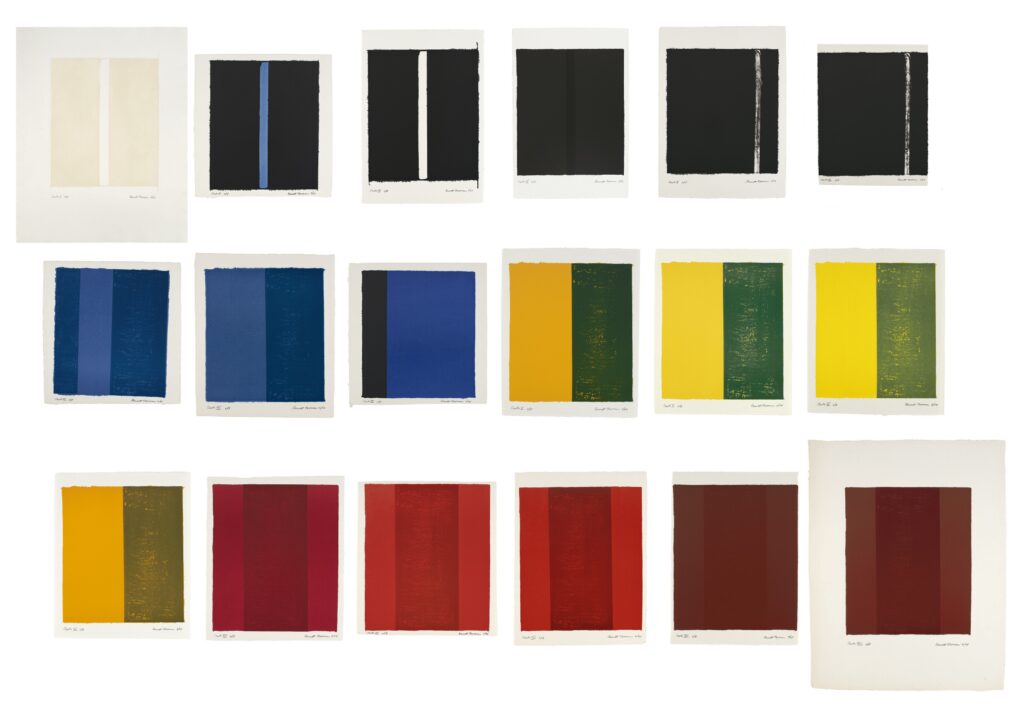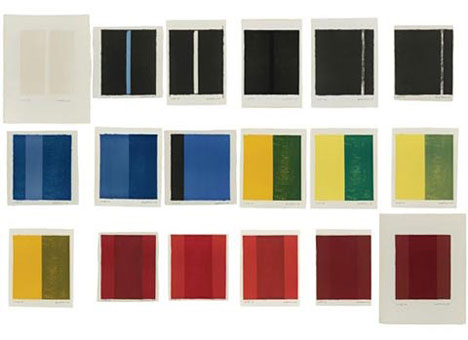
I never wish harder for several million extraneous dollars than when one of the greatest print projects in postwar art, Barnett Newman’s 18 Cantos, comes up for sale. At least it’s not a regular occurrence. This is the second time; the last was about fifteen years ago.
18 Cantos is being sold at Christie’s as part of a very high quality collection, assembled over decades by an unidentified corporation. It was asking myself which corporation, in 1964, would have gotten number two in an edition of eighteen, that made me think this is the collection of the David Rockefeller era of Chase Manhattan Bank. At least twelve of the 18 Cantos editions are in museums. At least a couple of have been broken up and are circulating individually, a print tragedy.
I didn’t know this sale was coming when I posted a couple of weeks ago about Barnett Newman’s comparison of lithography to playing an instrument, which has its own material and aesthetic “licks,” including the lithographic stones themselves, and the borders of the papers receiving the impression. As he explains in the text for 18 Cantos, Tatyana Grosman taught him this, that printing is not just replicating a painting; it’s its own thing.
And Newman took that to heart. The eighteen prints of are made with only a few stones, singly and in pairs, in differing orders; with unmixed French and American inks; on Japanese, English, and French paper in at least twelve sizes. The result is a printed fugue where the identical elements and minute differences between prints are as important to the artist as the specific composition of each print.
[UPDATE: I’m rereading the 2008 Sotheby’s lot text, which says, without sourcing, that Newman referred to the third “sequence,” the yellow-on-blue ink variations in Cantos X-XIII, as “The Four Seasons.” It also notes that two sets have been dispersed–but makes no mention of the as many as five A/Ps signed by Annalee Newman into the 1970s. It’s not clear whether any of those proofs were complete sets or all loosies. I wish there was more discussion of this project than just auction catalogues.]

Those resonances are clear in person, the reward for long looking and roaming among the prints. But some of these harmonies get flattened out online, like in reproductions of the whole suite, like the one up top, which haplessly resize individual prints to fit a graphic designer’s grid. I’ve made a quick adjustment to correct the major errors, but that feels like a rough mix, still in need of fine tuning. I was already thinking about Cantos a lot before this sale popped up, and I will keep jamming on it for a while, I’m sure. Meanwhile, if you have several unneeded millions of dollars handy in the next couple of weeks, HMU.
[day after update: sold, barely, for $2.107 million. pls let me know the tracking info for when you ship it to me, successful buyer.]

[upon even a minute’s rumination UPDATE] Great work everybody (me), I just made a halfbaked, slightly higher resolution version of the 2008 image I reposted in 2012 from Arcy Douglass’ amazing essay on 18 Cantos during their exhibition at the Portland Museum. So it’s really just a Christie’s problem. And a me problem for not looking in my open tabs.
2008: Barney and the Boundary: Barnett Newman’s 18 Cantos at PAM [portlandart.net]
